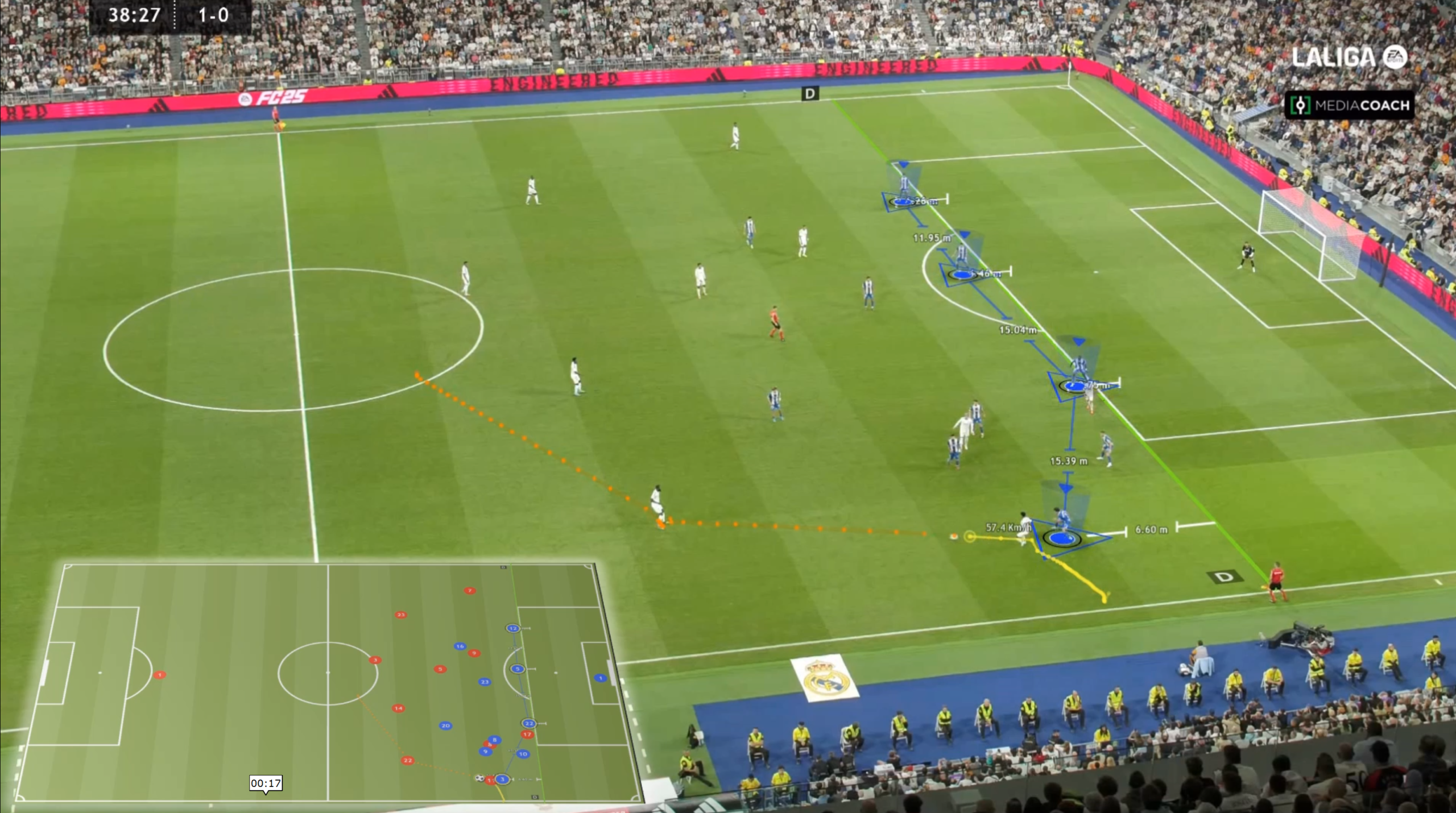
05 Nov Optimize Your Defensive Line: How Measuring Each Defender’s Individual Depth Can Strengthen Team Cohesion
In this research developed by LaLiga’s Sports Research Department using the Mediacoach Desktop tool, we delve into a crucial innovation for defensive analysis in football: measuring each defender’s depth with a fixed reference, the edge of the penalty area. This approach allows coaches to monitor and adjust each defender’s behavior in real-time to improve defensive cohesion, especially in zonal systems. Here’s a summary of the most relevant results and how to apply them practically as a coach.
1. Why Measure Individual Depth?
One of the biggest issues in defense is the lack of cohesion among defenders. For example, if a central defender drops too deep relative to the edge of the penalty area, they can inadvertently enable attackers, breaking the offside line. The research shows that measuring each defender’s distance from a fixed reference helps maintain a more compact line, reducing opponents’ opportunities to exploit positional errors. By measuring this individually, coaches can quickly detect if a defender is out of position and correct it in real time.
Practical Use: During training, use this reference to evaluate each defender’s depth and make individual adjustments to their positioning. In competition, this measurement helps avoid errors at key moments, like the final phase of the game, when fatigue might lead to misalignments in the defensive line.
2. Analyzing Amplitude and Depth Together, Adapted to Ball Position
In addition to depth, measuring the spacing between defenders (e.g., the distance between central defender and full-back) is essential. The research shows that if defenders’ spacing is too wide, opponents often find gaps to penetrate the line. Keeping the optimal distance between defenders helps protect the penalty area. However, the ideal distances depend heavily on the ball’s position and the closest opponent’s location. If the ball is in the center, the defensive line will stay more compact than when the ball is on the flanks, where defenders need to shift and adjust their positioning according to the closest opponent.
Practical Use: In lateral shifting exercises, ensure players understand the importance of maintaining both correct depth and spacing. For example, when the ball is on the wing, defenders on the far side should remain optimally positioned, not leaving room for the opponent to switch play.
3. Adjusting Based on Defensive Block (Low, Mid, or High)
Whether the team is defending in a low, mid, or high block, the defensive line must adjust differently. The research results indicate that the ideal distance between the defensive line and the penalty area changes according to block height, helping to reduce space behind the defense and block possible passing lanes. Additionally, this distance adjusts according to the ball’s position and the closest attacker, optimizing coverage and control in each block.
Practical Use: You can set specific distances for each player depending on the team’s defensive block. For example, in a mid-block, defenders should know exactly how far they can push up without leaving space behind, based on whether the ball is in the center or on the flanks.
4. Real-Time Alerts to Avoid Defensive Misalignments
A key innovation of this analysis is generating alerts when one of the defenders fails to maintain the correct distance in depth or width. The research shows that real-time monitoring can identify common errors, such as:
- Central defenders staying too deep or pushing up excessively.
- Full-backs opening too wide, creating gaps for passes through the middle.
- Defenders enabling offside positions by not aligning with the line.
- Incorrect lateral shifts based on the ball’s position or nearest opponent, making it easier for opponents to gain space.
Practical Use: During matches, this alert allows for instant tactical adjustments. As a coach, you can instruct a player to adjust their position before the opponent exploits a misalignment.
5. Tactical Planning Based on Real Data from Opponents’ Possessions
The model not only identifies misalignments but also analyzes the opponent’s possessions to see which defensive positions best neutralize their attacks. Research results show that possessions that don’t end in scoring chances occur when defenders maintain optimal width and depth in each situation, adjusted according to the ball’s position and the nearest attacker’s location. Use this analysis to create specific drills that simulate real match situations, where defenders learn to adjust their position based on ball position and proximity to the opponent.
Practical Use: During the week, set up sessions where defenders practice maintaining ideal distances from the penalty area edge while shifting laterally. This helps your players master positioning in different situations.
In Summary
This research provides a practical tool that enables coaches to measure each defender’s depth individually relative to the penalty area edge, maintaining a more solid and cohesive defensive block. With this real-time data, you can anticipate and correct defensive misalignments instantly, keep the line synchronized, and reduce the risk of opponent scoring chances. Applying these concepts can help improve your team’s defensive structure at every game phase.


